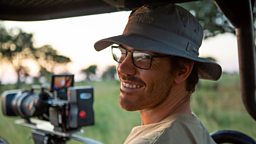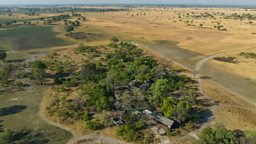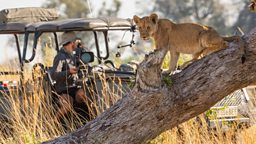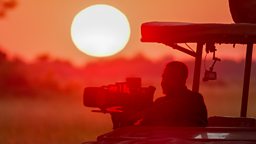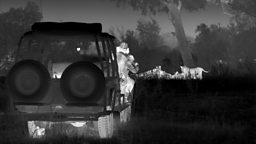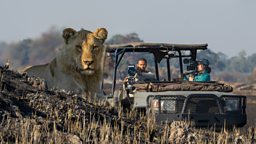Learning the language of the bush
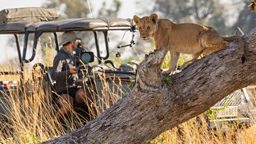
It’s all well and good setting out to film big cats but first you need to find them. Tracking down the cats in the vast landscape of the Okavango Delta requires special skills. It’s an investigative puzzle demanding Sherlock Holmes like perceptiveness and perseverance.
finding cats requires alertness day and night
Giving ourselves the best chance of finding cats requires alertness day and night and for this reason the Big Cats 24/7 team often sleeps atop the film trucks spread out across the wilderness. Lions and leopards are most active and vocal at night, with their calls audible over many miles.
As the cats move they also disturb other animals whose alarm calls can give us clues as to their direction of travel. We lay in our bedrolls on the trucks and listen for the faintest calls or disturbances. A distant lion roar in the north at 3:35am; a jackal alarm calling near the western floodplain at 5:15am.
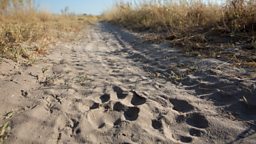
All of this information comes together on the morning radio check-in, with most of us still groggy but eager to get on top of the cat puzzle. Adding up each little piece of evidence allows us to deploy the team strategically and start searching in the most promising areas.
A trained eye with a good pair of binoculars can distinguish a relaxed impala from an alert one
It’s much easier to find a moving cat than one that is sleeping under a bush in the midday heat, and since all of the cats are likely to be more active during the cooler early morning, the first few hours of searching are vital. If the night has given us any clues we may travel to where we think the cats are while it is still dark and listen intently.
As the sun begins to illuminate the landscape we begin scanning the surroundings for visual signs of the cats or any signals from prey animals in the area. This is my favourite time, when a deep immersion in nature takes over your awareness and each sense is highly tuned in to the surroundings.
A trained eye with a good pair of binoculars can distinguish a relaxed impala from an alert one. A slightly raised head and neck with cocked ears is what we look for and if a herd have adopted this posture and are all looking in one direction you can be almost 100 percent certain that a predator is nearby.
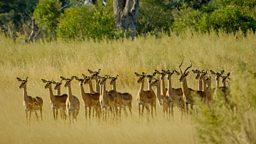
While scanning with binoculars, our ears are also straining to pick up auditory clues. Almost every animal from tree squirrels and vervet monkeys to larger wildebeest and zebra produce calls that communicate to others the presence of a predator. Vervet monkeys, impala and jackals go absolutely mental when they spot a leopard and baboons get particularly upset by lions. Some animals are more reliable indicators than others however, vervet monkeys and kudu rank amongst the most reliable and on the other side of the spectrum, tree squirrels and spurfowl can seemingly be as alarmed by their own shadow as by a leopard.
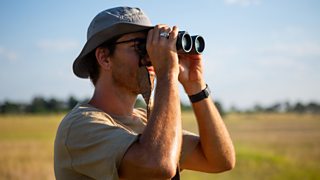
The process can also be very frustrating at times. One such moment involved a baboon hiding in a tree. In this situation it’s best to see which direction said baboon is looking as it barks its alarm and this inevitably will be the best area to search for the lions. I circled the tree with the baboon for many frustrating minutes and no matter the angle I could not see an ape of any sort.
It felt as if this baboon was really trying to mess with me and I could not help but use some seriously strong language in response. No visual of the baboon meant I had no idea which direction to search. In the end some worried-looking impala pointed me to the location of the lions, completing a process which took a little longer than I would have liked. From the depths of despair to the elation of finding the target all thanks to an invisible baboon who got the better of me.
The early hours of the morning are broken up into periods of looking, listening and driving. As we drive, much of our attention is also drawn down to the dirt tracks. Leopards and lions use these paths to traverse their territories, leaving paw prints and tell-tale signs as they move. If the prints are fresh, we may then decide to “track” the cat, ideally following the foot prints all the way to the animal or at least close enough to pick up on other clues.
If we fail to find the cats early in the day and the temperatures rise, we shift our strategy to a more expansive search with less stopping to listen and more driving. The key then becomes persistence. Some days we may each drive 30 miles or more searching, but typically the picture comes together quickly and we are lucky to find cats early and stick with them all day.
The endeavour of tracking is one of my favourite aspects of my work; a natural puzzle that brings one into full nature mode and feels extremely rewarding. There is no better rush than finally finding your target after hours of tracking.
